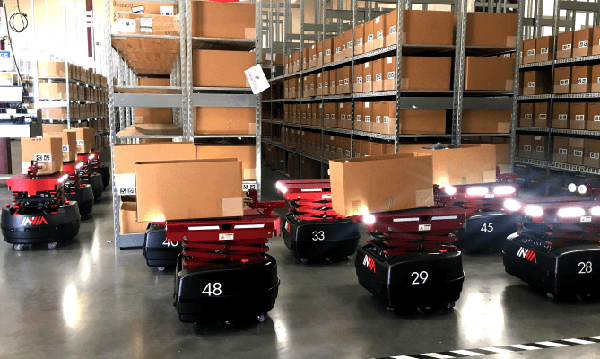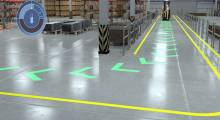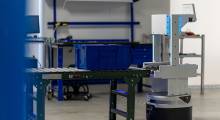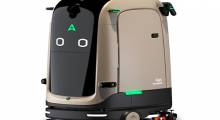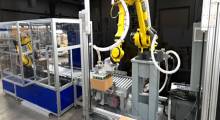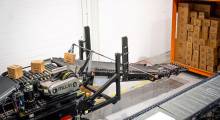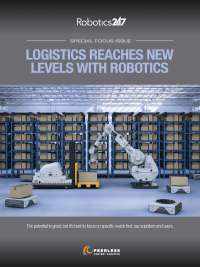Even before this year's holiday rush, retailers and logistics providers were struggling with snarled supply chains, labor turnover, and ever-growing needs for actionable data and throughput. The COVID-19 pandemic accelerated e-commerce demand and heightened worker shortages, but maturing automation can help, according to inVia Robotics Inc.
Westlake Village, Calif.-based inVia provides the Picker goods-to-person autonomous mobile robots (AMRs) and the inVia Logic software for orchestrating tasks and the movement of goods. The company raised $30 million in Series C funding in July.
1. Robots aid rather than replace workers
If robots handle repetitive tasks in quantity, that can free up people for qualitative work, such as creatively boxing orders, maintaining quality control, and collaborating with vendors to meet consumer demand, said inVia. By augmenting the workforce, robots can improve retention and productivity, it said.

“Companies are reporting that the rate of e-commerce growth, while still high, is slowing down because of shortages of labor and supplies,” said Lior Elazary, founder and CEO of inVia Robotics. “There's a finite capacity for production and logistics that is completely stretched. Markets are raising prices, partly to artificially slow it down. Everybody's trying to drink from a small hose, and there's a certain number of suppliers.”
“Eighty percent of warehouse work is done by hiring people,” he told Robotics 24/7. “But people just don't want to do this work. How do we create an environment where people want to work, so we have a bigger hose with the same resources? We can't have half the U.S. ordering things and the other half picking.”
“I don't like the term 'shortage of labor,' which sounds like we once had more labor,” Elazary said. “Labor is maxed out to old processes. The ports of Los Angeles and Long Beach recently expanded to 24/7 operations because of supply chain problems. We have to make sure that the warehouses of the future are more accommodating for workers.”
“How do we enable all of logistics to grow 10x without growing the number of people in the industry?” he said. “Companies that haven't automated their warehouses will start to feel more pain.”
“We face similar challenges ourselves,” Elazary noted. “We're also trying to hire more people to build and deploy robots.”
2. Safety, satisfaction improve with automation
inVia said its robots can reduce the amount of walking done by warehouse associates each day in half, helping them avoid musculoskeletal injuries.
“We've gone to warehouses where people were carrying around ladders and walking miles,” said Elazary. “Most customers don't gather any statistics and don't want to talk about it. They do appreciate when people can operate in their own areas.”
“If a shuttle in an ASRS [automated storage and retrieval system] breaks, you have to shut down the whole system to get it,” he said. “The benefit of a system like ours is that if one robot shuts down, the whole system keeps going.”
“Our Picker robots are relatively light and nonthreatening, and we developed PickerWall so robots and people don't always have to work in the same area,” Elazary said.
“We talk a lot about physical safety, but we also think about mental health,” said Kristen Moore, chief marketing officer at inVia. “Before we had the pickwall, we originally had more direct robot-to-human interactions, but then people had to work nonstop. With the wall, people can work in bursts or on multiple activities.”
“One customer took that to an extreme,” Elazary added. “Workers were really having fun picking. They'd get orders and then play guitar. We're really proud of that, because we don't want people to feel that working with robots is a menial job. They should be able to take bathroom breaks and enjoy gamification while producing as much as possible.”
3. AMRs and software can increase productivity
One robot can take on the tasks of moving, reaching, and lifting for up to four employees, resulting in a five to 10x average increase in throughput, according to Moore.
“Consumers are very unforgiving,” Elazary said. “If their Christmas presents don't arrive on time, they won't order from that retailer again. That's driving innovation.”
“Robotics is one way to expand throughput with the same labor supply,” he said. “This also gets to the idea of tasks versus jobs. The jobs remain the same—fulfilling orders—but the tasks are different. Instead of running around, wranglers are now managing robots.”
“Not only is inVia able to get picking and replenishment faster, but now we're being asked for other processes,” said Elazary. “With presales, companies may be expecting 1,000 orders of a hot toy against inventory in high-bay storage. They need a pallet as quickly as possible.”
“While our robots aren't managing pallets, they can help with other demand around presale orders, such as adding a toothbrush or a flashlight to an order,” he explained. “It's a complex long tail, with people marrying orders. It's really about the flow management system.”
4. inVia Logic guides robots plus people
“We recently went live with our software guiding customers' forklifts just like our robots,” Elazary said. “Two people would choose the same aisle and get stuck, but inVia Logic can keep everything flowing. Every customer has certain processes—some pick from a cherrypicker versus a lift truck. Our software can guide people and robots to get more work done.”
“One thing that's unique about our mobile software for directing people is that it's on a wearable device on the associate's arm, rather than instructions on the robot,” said Moore. “It's really intuitive, helping people be more productive right away.”
How is inVia's software different from a warehouse execution system (WES)?
“The biggest difference is that WESes don't look into the future and aren't able to change plans,” Elazary replied. “Not only can our software have a plan to direct robots and people for the whole day, but every five seconds, that plan gets recomputed. From a person spending time on the phone rather than picking to scheduling packers, our plans can change in waves, and we can be as flexible as possible.”
“We can still do batching, but we've been working for several years to get our system to change in real time while providing guidance,” he said. “Our robot hardware hasn't changed much, but our software has, making deployments faster and easier.”
“It's important for robots to adapt to existing infrastructure, such as shelves and totes,” said Elazary. “In March 2020, inVia's robots could drive through and map a warehouse by themselves.”
“In the warehouse, everything has to flow, but it can't if secondary processes aren't met,” he noted. “We've added more tools to allow staffers to configure and deploy systems and to adapt to other warehouse processes. We have particular configurations for packout with QR codes in the inVia PickMate software. Another one is the 'hospital,' where orders are fixed if there's, say, a missing item.”
5. RaaS eases scaling
inVia said its robotics-as-a-service (RaaS) model can help operations without prior experience add robots.
“RaaS is similar to SaaS [software as a service],” said Elazary. “It's not a lease with inVia. We have a contractual agreement with the customer based on the number of orders it wants fulfilled with a certain number of hours. Unlike buying or leasing robots, we're on the hook if the system doesn't perform at 1,000 orders per hour.”
“The warehouse manager can see the metrics of packouts, etc.—it's like driving a fast car and watching the gauges—you can address problems immediately,” he said. “The system can address these itself, but it can also ask for help. The customer doesn't care about how many robots are on the floor but how many products go out the door. They don't want to be engineers.”
“One constant is always our SLAs [service-level agreements] with the customers,” said Moore. “A lot of systems don't understand SLAs, but our customers give us a time for when every order must be fulfilled. We can give it a priority listing and issue a replenishment order or get someone else to fill it.”
“We work with warehouse management systems [WMSes],” Elazary said. “A lot of them get all the orders and then send picking jobs. They then wait for completion—good luck.”
“We're in on the execution of the orders,” he said. “We don't have any customer information; all we do is have a collected group of items. The WMS gets the orders, hands them off to us, and then our order management software and SLA determine the flow of items, depending on when they have to leave the warehouse. We then hand it back to the warehouse after it's done for printing the barcode and shipping.”
inVia sees record growth
“For us, this quarter has been our biggest to date as far as bookings,” said Elazary. “Usually, the fourth quarter is the slowest, but both compared with other quarters and year over year, it's the highest. Our customers are trying to figure out how to supply their customers, and robots and automation is the way to do it.”
“inVia had several deployments go live right before peak,” he said. “One customer signed up with us only two months ago and needed AMRs in three warehouses right off the bat. You couldn't do that with traditional automation in a brownfield.”
“We have a bunch of deployments coming in January, and our pipeline is full,” added Elazary.
Robots as the future of fulfillment
“Looking ahead, there are two drivers for innovations in the warehouse,” said Elazary. “The first is that consumers want instant gratification, like a Star Trek replicator. The second is that because of the pandemic, there's more demand for remote work, such as teleoperating forklifts. We'll also start to see warehouses for groceries.”
“A lot of people want to create the warehouse of the future or the lights-out warehouse,” said Moore. “But we still have a capacity crunch on warehouse space, location, and utilization that we'll be watching.”
“Our midsize and enterprise customers are trying to move as quickly as possible,” Elazary said. “With peak season, we'll see a lot more automation for fulfillment and more customers demanding robots that are easy, safe, and fun to work with.”
About the Author
Follow Robotics 24/7 on Linkedin
Article topics
Email Sign Up

